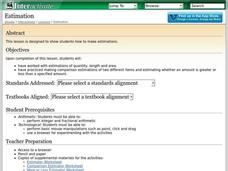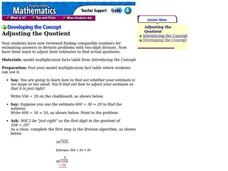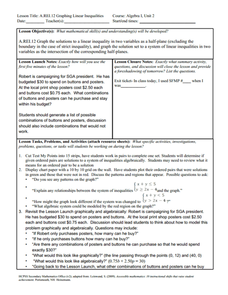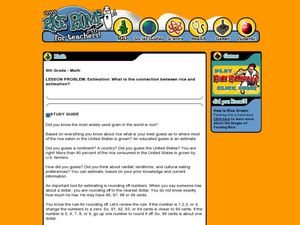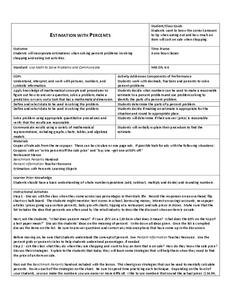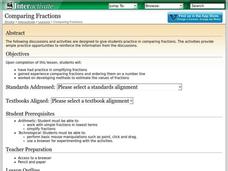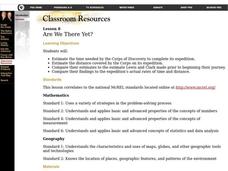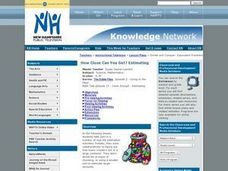Curated OER
Estimation
Students explore the concept of estimation. In this estimation activity, students discuss making estimates through teacher led discussion. Students use the Internet to complete an activity where they must estimate the length of lines.
Curated OER
Examining Estimation
Second graders participate in various activities which help them explain and explain the difference between an estimate and an exact amount.
Curated OER
Adjusting the Quotient
Learners solve division problems. In this division lesson, students review estimating and how to figure out if their estimate is too large or too small. Learners solve division problems and use their estimating skills to adjust the...
Curated OER
M&M Caper
Students participate in a game with M&M's to be introduced to percents and ratios. Individually, they estimate and record the number of candies they believe the bag holds and the amount of each colored candy. They open the bag and...
Curated OER
Graphing Linear Inequalities
Eighth graders extend skills for representing and solving linear equations to linear inequalities. Lesson activities build understanding and skill by plotting ordered pairs of numbers that either satisfy or do not satisfy a given...
Curated OER
Centimeter Slinkies
Third graders estimate and measure the length of a whole color-segmented, candy gummy worm. Then, as students bite off each segment, they estimate, measure and record findings in an activity log.
Curated OER
Estimating Sums and Differences
In this math worksheet, pupils learn to estimate sums and differences by completing step by step exercises. There is one word problem which is the example, and then students can choose from other estimation activities to do with a partner.
Curated OER
What is the connection between rice and estimation?
Sixth graders investigate estimating. In this estimating lesson, 6th graders estimate how much rice is eaten around the world. Students estimate the percentages of rice eaten by other countries. Students compare rice production to other...
Curated OER
How Much Is On The Floor?
Students estimate the number of items in a group. In this estimation lesson, students are presented with random objects to clean up. Students estimate how many items are present and then compare the actual number of items to their...
Curated OER
Estimation With Percents
Students examine percents. In this percents lesson, students will estimate percentages. Using advertisements from a newspaper, students problem solve to determine the final price of a sale item.
Curated OER
Comparing Fractions
Students discuss the nature of fractions and compare fractions based on a similar whole to determine relative size.
Curated OER
Comparing Fractions
Pupils use the assistance of computers to explore reducing fractions. Using various internet activities, students experience comparing and ordering fractions. They develop methods to estimate the value of fractions.
Curated OER
Paper Packaging Design
Students create packages with a maximum capacity. In this geometry lesson ,students estimate using whole numbers, decimals and fractions. They calculate length, weight and mass of packaging.
Pennsylvania Department of Education
Adding Common Fractions
Fourth graders estimate various measurements. For this lesson on measurement, 4th graders estimate the length and mass of multiple objects. Students discuss the difference between a guess and a reasonable estimate and discuss using...
Curated OER
Are We There Yet?
Students estimate the time needed by the Corps of Discovery to complete its expedition. They problem solve and estimate the distance covered by the Corps on its expedition. They compare their findings to the expedition's actual rates...
Curated OER
Estimation
Students complete computer activities about estimating if items are more or less than a given amount. For this estimation lesson plan, students also estimate measurements around the classroom.
Curated OER
Using Math with Sale Papers
Fifth graders estimate their results and then prove through calculations. In this math lesson, 5th graders solve problems using multiplication, division, addition, and subtraction. They also use mental math to solve their problems.
Curated OER
M & M Math
Pupils sort M & Ms by a given attribute, and estimate how many M & Ms are in two bags. They graph their M & Ms and conclude which color they have the most and least of, then students combine sets of M & Ms together and...
Curated OER
Sum of the Parts
Fifth graders build objects using various materials. They estimate the weight of the object using individual building pieces. Then they weigh the actual object and then tear it apart and weigh the pieces. They compare the two weights.
Curated OER
How Close Can You Get? Estimating
Young scholars work collaboratively to determine how many crackers are in a large container. They then view a video to see how often people use estimation in their jobs, and another video to watch students work on figuring out...
Curated OER
Commutative Property
First graders investigate the Commutative Property of Addition. It is introduced using models such as students, counters, balances and dominoes. They discover the order of the numbers in an addition sentence does not change the result...
Curated OER
Math in Society
Twelfth graders determine probabilities of real-life events such as life expectancies, winning a lottery ticket and the break-even premium. They apply how life-expectation tables are used to estimate the probability that an individual...
Curated OER
Estimating With Fractions
Seventh graders, exploring methods to estimate fractions, take notes on estimating fractions, 7th graders write letters to explain the process of estimating fractions and mixed numbers to someone who does not know the concept. Students...
Curated OER
Slosh, Dribble, and Plop
Students recognize the need for a standard unit of volume. They estimate and measure to the nearest liter. Also they relate the liter to the familiar everyday containers.
Other popular searches
- Compatible Numbers to Estimate
- Estimate Numbers Lesson Plan
- Estimate Numbers Grade 5
- Round and Estimate Numbers


